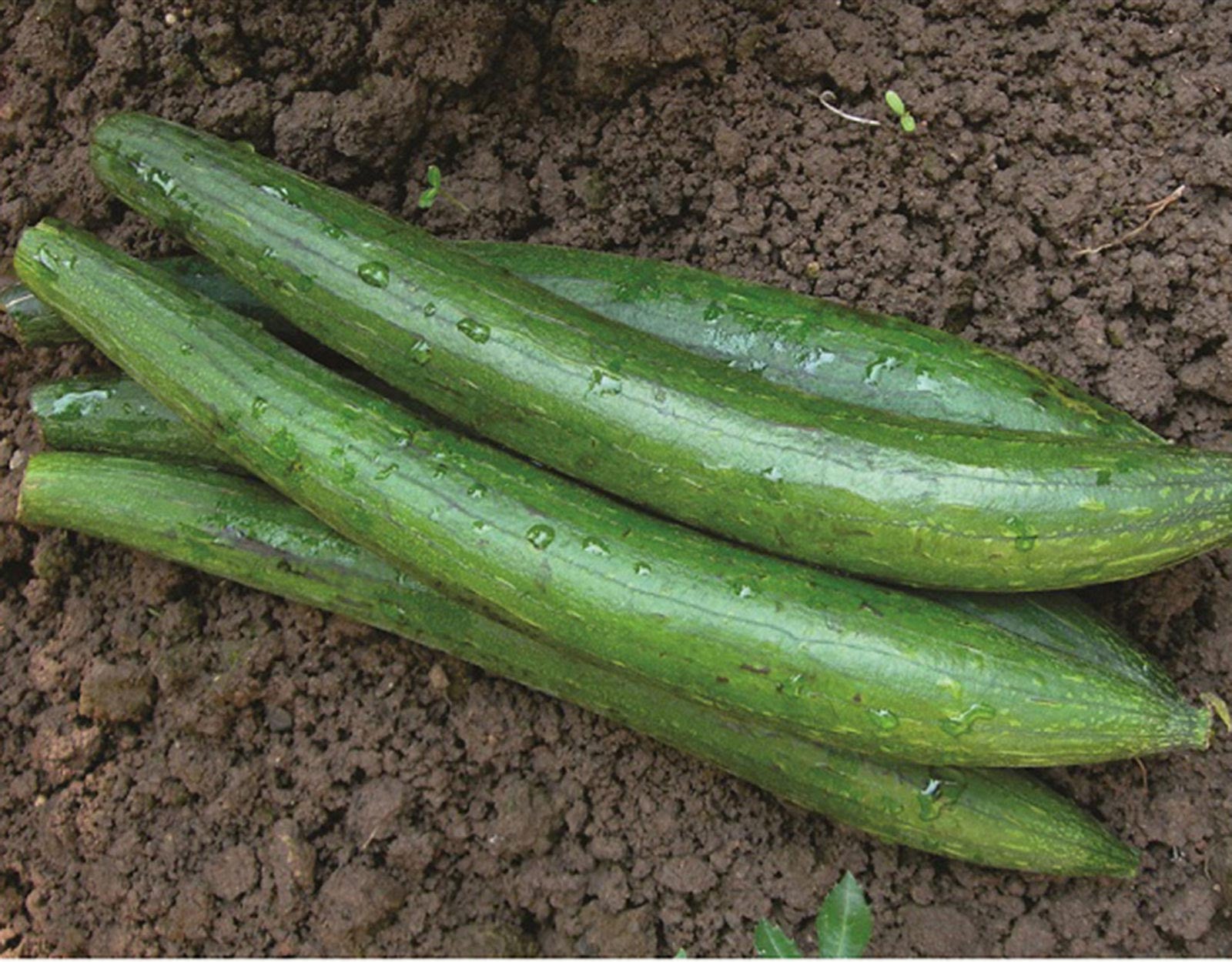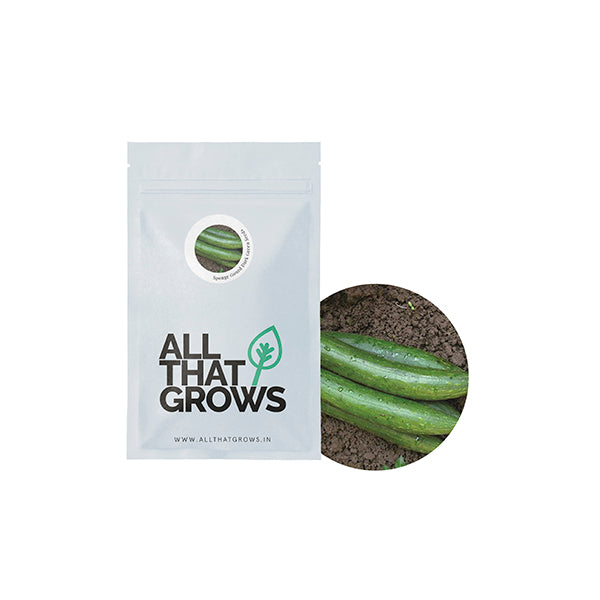



Sponge Gourd Dark Green Seeds
Seed Type : Non-Hybrid, Open Pollinated and Non-GMO
Plants : Very long veins, well branched
Sowing time : Summer as well as rainy season
Fruit: Dark green, slight black lining all over the skin, cylindrical in shape
Fruit length : 8-9 inches
First picking : After 50-55 days from sowing
Specification : Very attractive fruits, high yielding, suitable for long distance transportation
- SOWING
TIMESummer
& rainy season - Sowing
DistancePlant to plant - 1'
Line to line - 4' - Fruit
Weight100 - 150 gms
- Fruit
Shapelong
- Days to
maturity50-55 days
- Details
- How to sow
- Reviews
The Luffa or the dark green sponge belongs to the Cucurbitaceae family. It is widely cultivated in India and the Americas. However, it is easiest to grow in the tropical and sub-tropical climates which means that if you are in India, then your backyards! The Sponge gourd / Luffa or the Tori is a highly fibrous vegetable and has a flavor and taste which is similar to bitter melon. It's a nutrient-dense green veggie that you can rely on for a rich supply of anti-oxidants, minerals, vitamins, dietary essentials such as lipids and good carbohydrates. Sponge gourd offers Vitamin C and B6 in abundance quantities along with Magnesium which itself performs key roles in the human physiology. Because the sponge gourd is low on carbohydrates, it is highly recommended for people suffering from diabetes. Luffa or the Tori, is in fact, believed to have many medicinal qualities. Vitamin A in this gourd prevents macular degeneration which leads to blindness. The vegetable even prevents cardiovascular ailments thanks to the Vitamin B5 which lowers bad Cholestrol in the blood. Apart from this the sponge gourd is extremely good for skin health, treating migraine headaches, and providing the necessary cooling to the body when it heats up.
You can add the Luffa to your salads by steaming or blanching them, to your chutneys for that peculiar bitter flavor, cook them in a curry, or simply saute. There are many traditional and modern ways to cook and eat the sponge gourd! But first, sow them in your garden for a healthy supply!
Planting instructions
Seeds can also be started indoors near to the last leg of the winter.
Sow gourd seeds 8 to 12 inches apart as soon as the soil is warm enough to germinate and there is no danger of frost anymore.
Plant one to three plants in a hill and space hills 6 feet apart. To facilitate germination, scrape the seed coat with a file or allow seeds to stay warm for at least 24 hours.
Note - Seeds are really slow to germinate.
Growing Requirements
watering
The plants can't survive muddy waterlogged soil. Keep the soil moist but not soggy.
pests
Sponge gourds are affected by a range of fungi and viruses. They are susceptible to a wide range of insects which leave them with the following symptoms: leaves begin to curl and eventually die; lesions exuding a milky substance which dries to form a white crust on. Beside lesions; fruits can get small and pale in color etc. The following pests attck this cropBacterial leaf spot, Aphids, Cucumber beetles, Downy mildew.
soil
They like well-drained loamy soil with a soil pH in the range of 5.8 to 6.4.
spot
Gourds should be planted outdoors in full sunlight.
temperature
Gourds grow best in temperatures between 23 to 29 C [75 and 85 degrees Fahrenheit].
how to harvest
When your gourds have reached their full size, the vine they’re growing on will start to die off on its own.
Look into the gourds on a weekly basis to distinguish if they’re ready. Feel the skin and check the firmness of the calabashes.
Treat the shell of the plant. Wash the gourd with dish detergent and warm water to kill off any bacteria.
Consider saving the seeds and roasting them. Your gourd will last for many years.

Customer Reviews
The productiveness of any seed we sell is subject to your local climatic conditions*, the sowing method you adopt, and your commitment to the planting process. We give no warranty, expressed or implied, and are in no way responsible for the produce.
Please note that all our seasonal recommendations/ sowing information is as per the local climatic conditions. *For more information on the optimum conditions required for growing seeds in your region, please contact us at, hello@allthatgrows.in or Whatsapp us at, +91 8544865077
Questions & Answers
Have a Question?
Be the first to ask a question about this.




Sponge Gourd Dark Green Seeds
Seed Type : Non-Hybrid, Open Pollinated and Non-GMO
Plants : Very long veins, well branched
Sowing time : Summer as well as rainy season
Fruit: Dark green, slight black lining all over the skin, cylindrical in shape
Fruit length : 8-9 inches
First picking : After 50-55 days from sowing
Specification : Very attractive fruits, high yielding, suitable for long distance transportation
The Luffa or the dark green sponge belongs to the Cucurbitaceae family. It is widely cultivated in India and the Americas. However, it is easiest to grow in the tropical and sub-tropical climates which means that if you are in India, then your backyards! The Sponge gourd / Luffa or the Tori is a highly fibrous vegetable and has a flavor and taste which is similar to bitter melon. It's a nutrient-dense green veggie that you can rely on for a rich supply of anti-oxidants, minerals, vitamins, dietary essentials such as lipids and good carbohydrates. Sponge gourd offers Vitamin C and B6 in abundance quantities along with Magnesium which itself performs key roles in the human physiology. Because the sponge gourd is low on carbohydrates, it is highly recommended for people suffering from diabetes. Luffa or the Tori, is in fact, believed to have many medicinal qualities. Vitamin A in this gourd prevents macular degeneration which leads to blindness. The vegetable even prevents cardiovascular ailments thanks to the Vitamin B5 which lowers bad Cholestrol in the blood. Apart from this the sponge gourd is extremely good for skin health, treating migraine headaches, and providing the necessary cooling to the body when it heats up.
You can add the Luffa to your salads by steaming or blanching them, to your chutneys for that peculiar bitter flavor, cook them in a curry, or simply saute. There are many traditional and modern ways to cook and eat the sponge gourd! But first, sow them in your garden for a healthy supply!
Seed Type : Non-Hybrid, Open Pollinated and Non-GMO
Plants : Very long veins, well branched
Sowing time : Summer as well as rainy season
Fruit: Dark green, slight black lining all over the skin, cylindrical in shape
Fruit length : 8-9 inches
First picking : After 50-55 days from sowing
Specification : Very attractive fruits, high yielding, suitable for long distance transportation
- SOWING
TIMESummer
& rainy season - Sowing
DistancePlant to plant - 1'
Line to line - 4' - Fruit
Weight100 - 150 gms
- Fruit
Shapelong
- Days to
maturity50-55 days
Planting instructions
Seeds can also be started indoors near to the last leg of the winter.
Sow gourd seeds 8 to 12 inches apart as soon as the soil is warm enough to germinate and there is no danger of frost anymore.
Plant one to three plants in a hill and space hills 6 feet apart. To facilitate germination, scrape the seed coat with a file or allow seeds to stay warm for at least 24 hours.
Note - Seeds are really slow to germinate.
Growing Requirements
watering
The plants can't survive muddy waterlogged soil. Keep the soil moist but not soggy.
pests
Sponge gourds are affected by a range of fungi and viruses. They are susceptible to a wide range of insects which leave them with the following symptoms: leaves begin to curl and eventually die; lesions exuding a milky substance which dries to form a white crust on. Beside lesions; fruits can get small and pale in color etc. The following pests attck this cropBacterial leaf spot, Aphids, Cucumber beetles, Downy mildew.
soil
They like well-drained loamy soil with a soil pH in the range of 5.8 to 6.4.
spot
Gourds should be planted outdoors in full sunlight.
temperature
Gourds grow best in temperatures between 23 to 29 C [75 and 85 degrees Fahrenheit].
how to harvest
When your gourds have reached their full size, the vine they’re growing on will start to die off on its own.
Look into the gourds on a weekly basis to distinguish if they’re ready. Feel the skin and check the firmness of the calabashes.
Treat the shell of the plant. Wash the gourd with dish detergent and warm water to kill off any bacteria.
Consider saving the seeds and roasting them. Your gourd will last for many years.



 Sign In
Sign In








